Port Timeline
Today
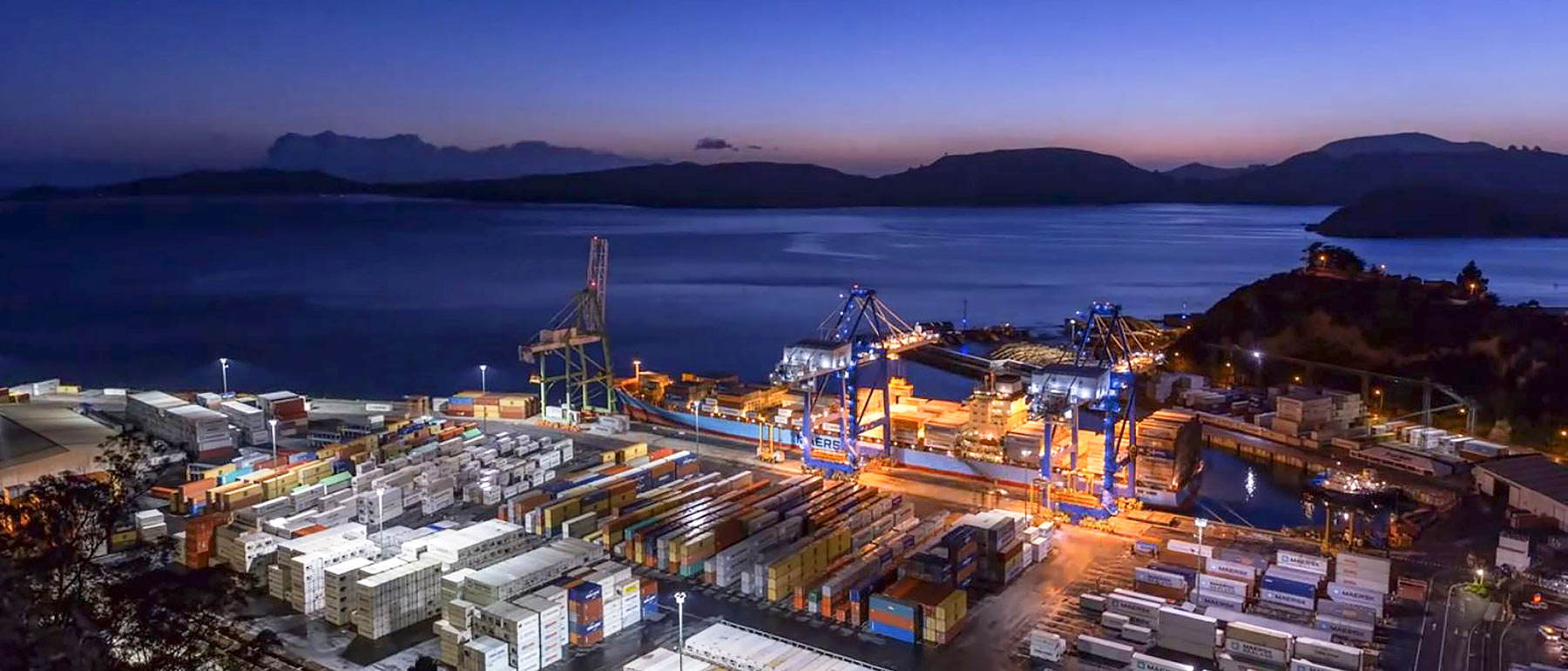
Always open port
Today, Port Otago is the lower South Island's main port for exports. It benefits from a deep natural harbour, a strategic location for vessel rotation to and from deep-sea destinations and a large primary export cargo region. The port leverages existing infrastructure to be always open, by using in-house dredging capability and renewable harbour defences. The team adapts quickly to provide space to customers and their changing needs. Opened in October 2024, the public viewing gallery allows our community and visitors to view the port’s operations up close.
2000s
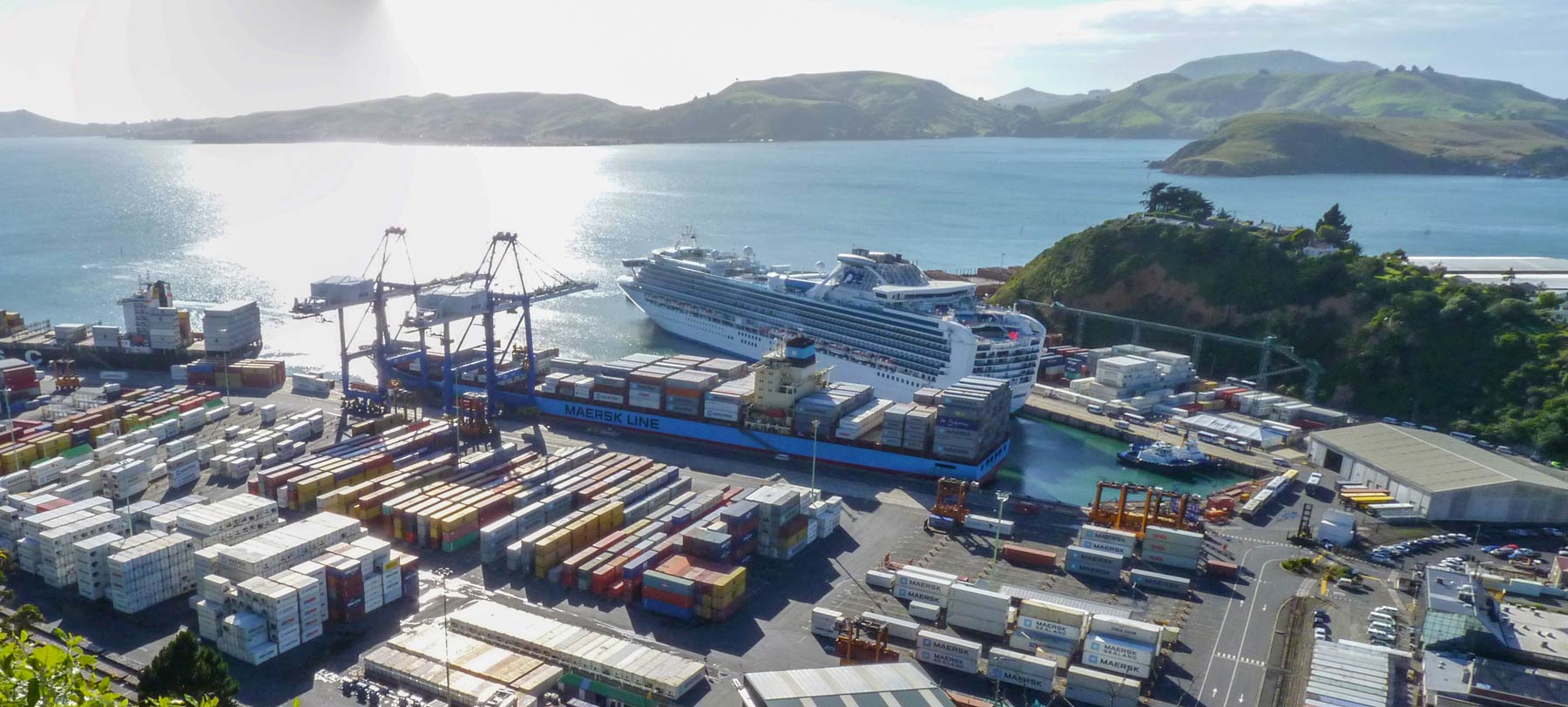
Multipurpose Wharf extension
In 2018, extension of the Multipurpose Wharf commenced. An additional 135 metres increased the combined container wharf length to 731 metres, allowing the port to cater for log, container and cruise ships across three berths. The $23m extension was constructed using 138 32-metre-long reinforced concrete piles, each requiring 30 cubic metres of concrete in order to support the concrete wharf deck. More than 5,000 cubic metres of concrete across 11 pours was used during construction. Totalling in excess of 75,000 man hours, the project was completed five weeks ahead of schedule and opened in 2019.
1970s
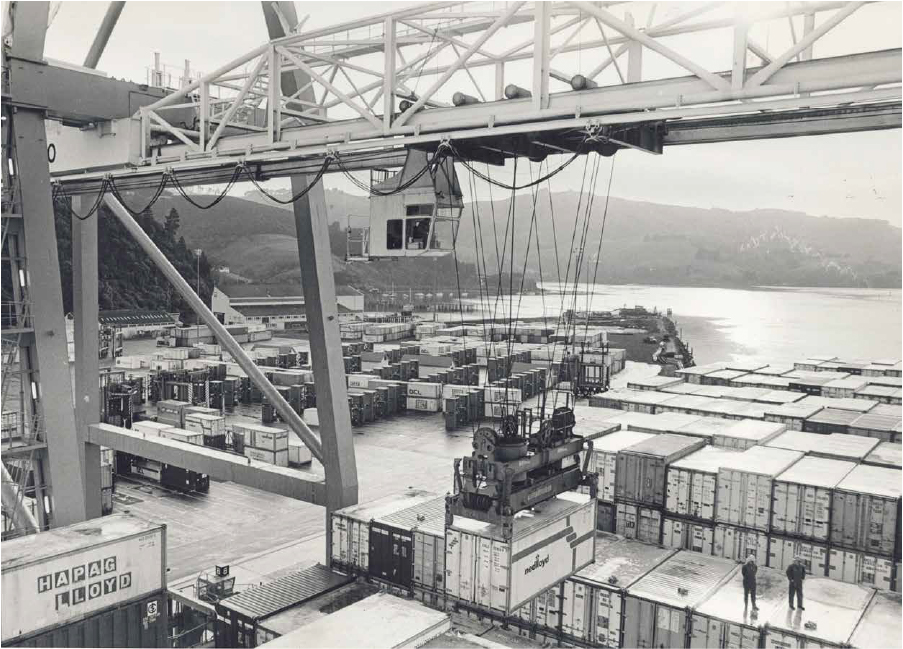
Containerisation
In the 1970s containerisation changed the very look of New Zealand ports. Port Chalmers along with Auckland, Wellington, and Lyttelton reclaimed large areas of land, filled in old wharves and dry docks, demolished wharf sheds and installed massive ship-to-shore gantry cranes. In Port Chalmers, the railway piers were mostly removed to create the Container Terminal Wharf which, along with the Beach Street Wharf, allowed for two large ships to be serviced concurrently.
1960s
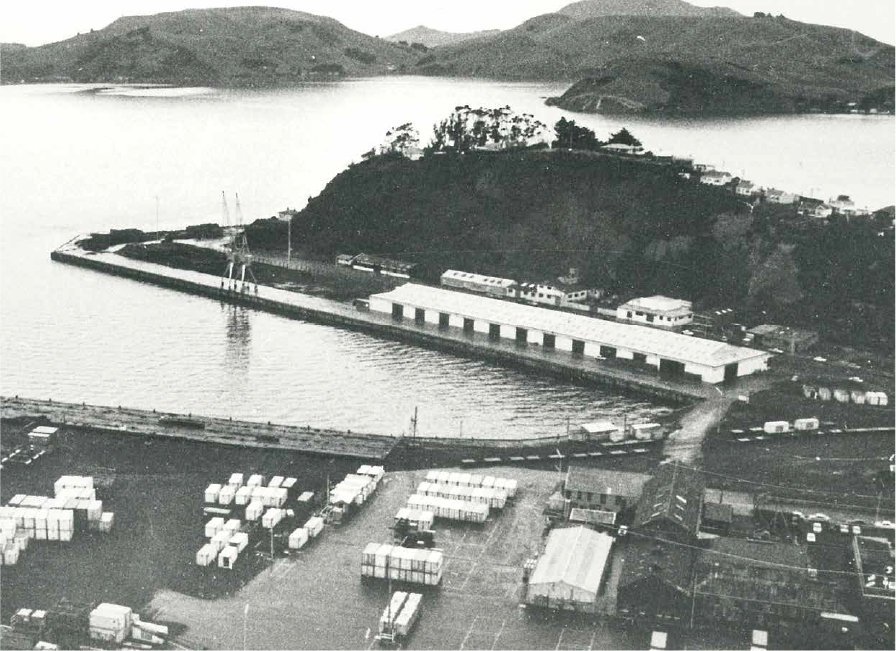
Beach Street Wharf
In the late 1960s rock was removed from the east side of the Port Chalmers basin to provide a trench bed for the caissons for Beach Street Wharf and to deepen part of what was to become the berths at Beach Street. A caisson is a watertight retaining structure and divers were needed during construction, often diving all day in freezing conditions with poor visibility. Rock from the caisson trench was used to backfill behind the caissons.
1930 - 1950
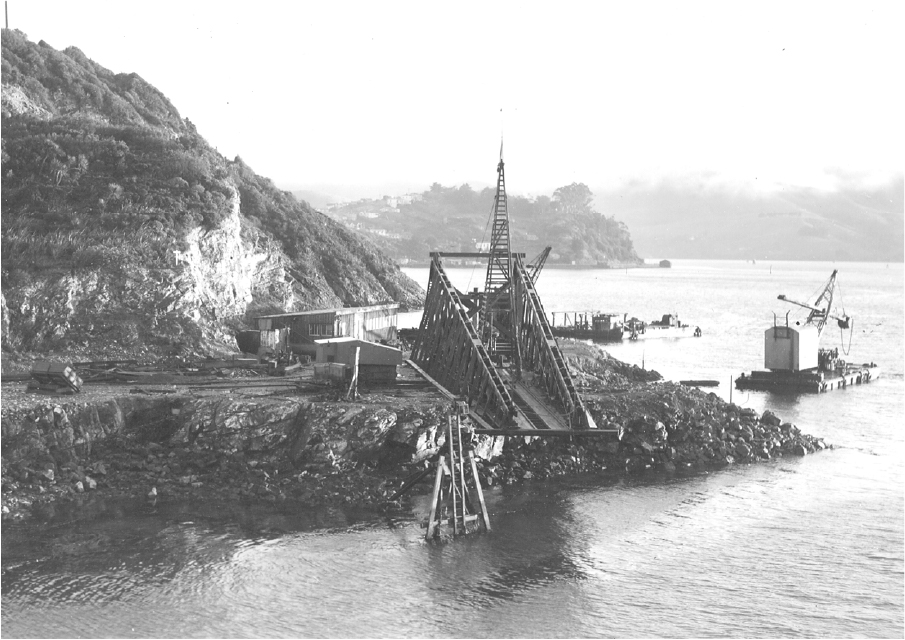
Goat Island channel widening
In the 1930s a rock spur which extended into the channel from Goat Island (Rakiriri) was removed by blasting. This was followed by a major project which ran from 1950 to 1955 when the channel between the islands was widened by 100 feet by cutting a bench on the Goat Island side to a depth of 30 feet at low tide. The blasting, completed in 1954, was reported to be responsible for damage to windows, chimneys and drains in the Port Chalmers area.
1900 - 1930
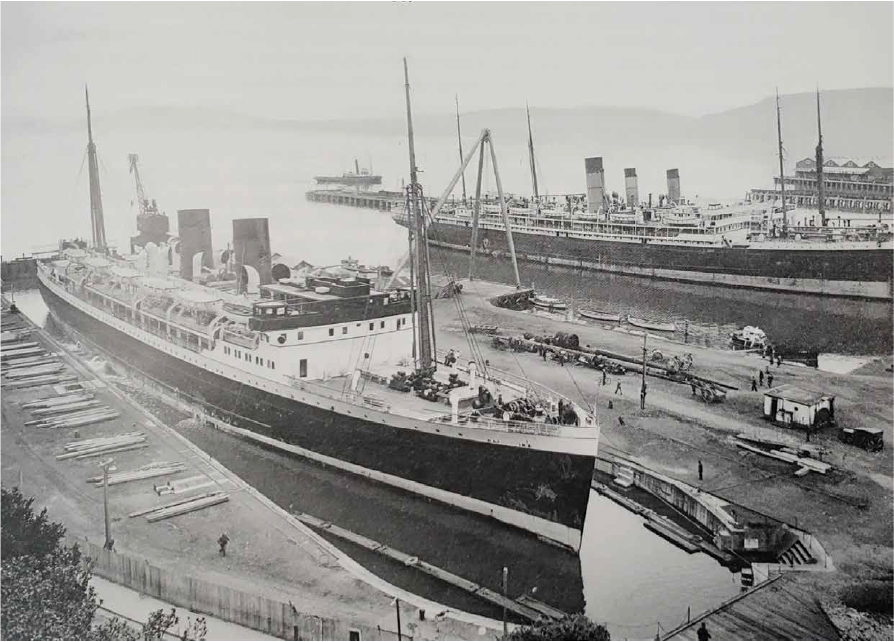
Otago Dock
Due to ever-increasing ship size, the construction of the Otago Dock graving dock commenced in 1905 with a timber coffer dam built by three shifts of men working around the clock under electric lighting. The dam was drained, and mud and silt excavated to make way for the foundations and stonework of the dock. Otago Dock was officially opened on 30 June 1909. Pictured is the ferry Rangatira in Otago Dock, 1930s.
1874 - 1900
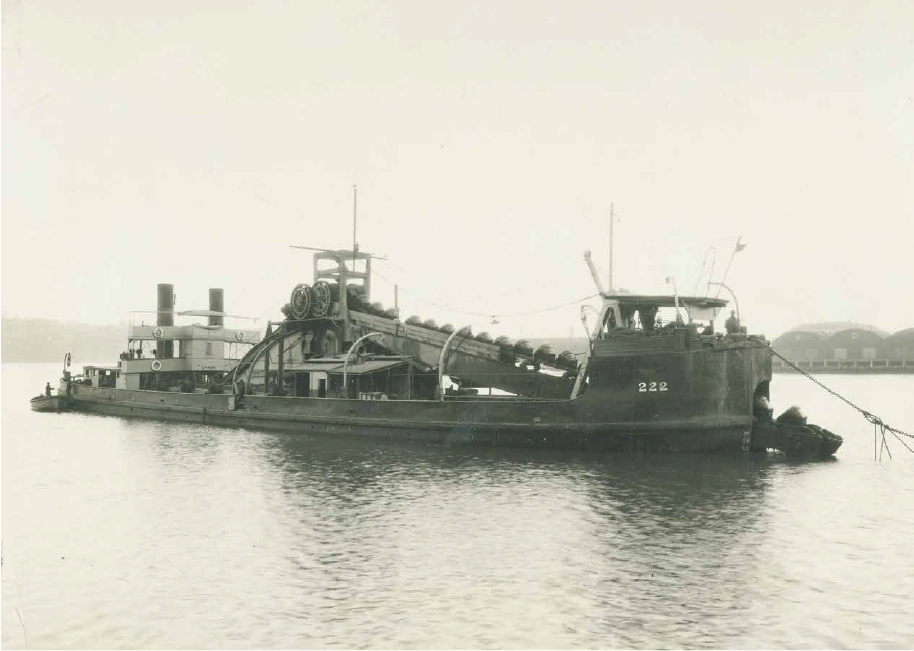
Victoria Channel
The first major project undertaken by the Otago Harbour Board after its
establishment in June 1874 was the controversial dredging of the Victoria Channel from Port Chalmers to Dunedin, allowing ocean-going vessels to reach the city’s wharves. Dredge 222 lifted more than 9,000 cubic metres from Victoria Channel, from the islands to steamer basin, and from the Victoria Wharf berths in Dunedin. The channel opened in 1881 and remains key to the operation of the port today.
1873
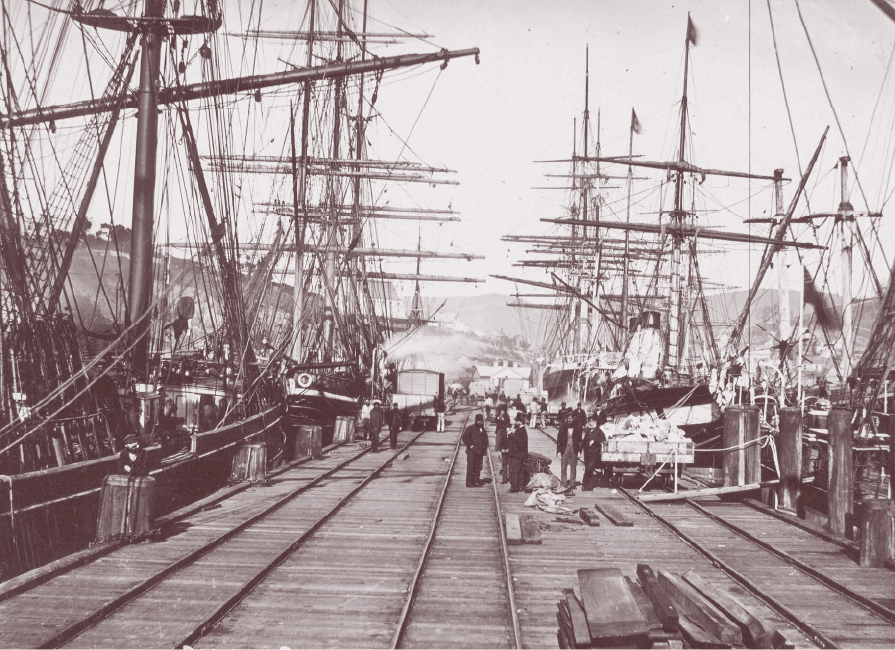
Railway piers
In January 1873 the railway connecting Port Chalmers and Dunedin was opened for traffic by the Governor, Sir George Bowen. That same day, Lady Bowen christened the recently-built Bowen Pier, one of three railway piers, which along with the Export Pier and George Street Pier, provided deep-water berths for vessels. The Union Steam Ship Company purchased the hulk of the barque Don Juan in 1878 and moored it between the Bowen and George Street Piers for use as a carpenters workshop and sailmakers loft.
1868
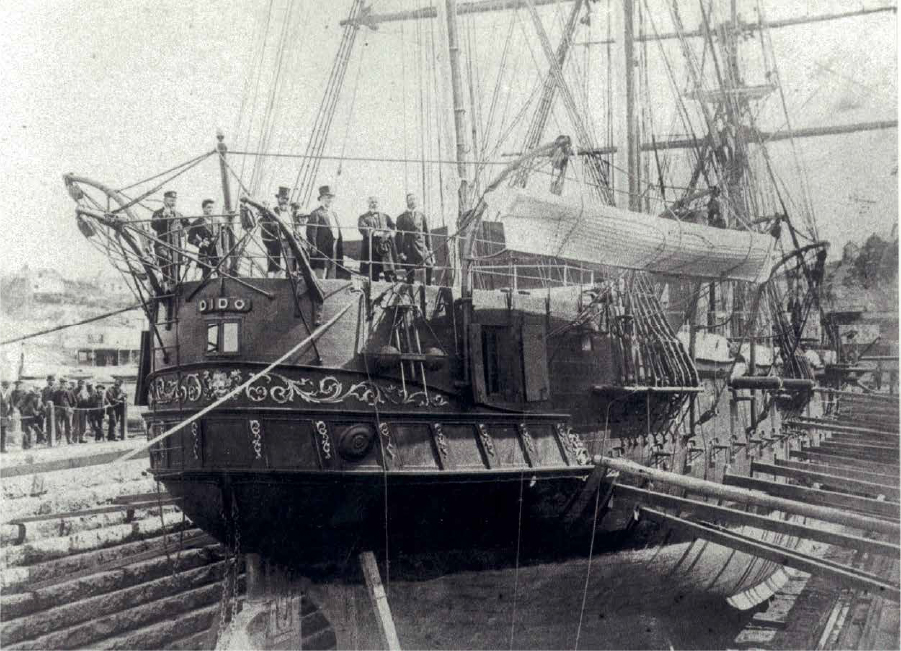
Port Chalmers Dock
On 16 July 1868 Superintendent of Otago, James Macandrew wheeled the first barrow-load of rubble to start construction of the Port Chalmers graving dock, a dry dock suitable for larger vessels. The build took four years, a tremendous undertaking considering that the 1,400 tonnes of Portland cement was mixed by hand. The floor and walls were lined with 90,000 cubic feet of local Port Chalmers breccia. The first vessel to enter the gate was SS Phoebe on 12 May 1871 and the dock was commissioned in March 1872. Pictured is the HMS Dido, the first warship to use the dock in December 1872
1860s
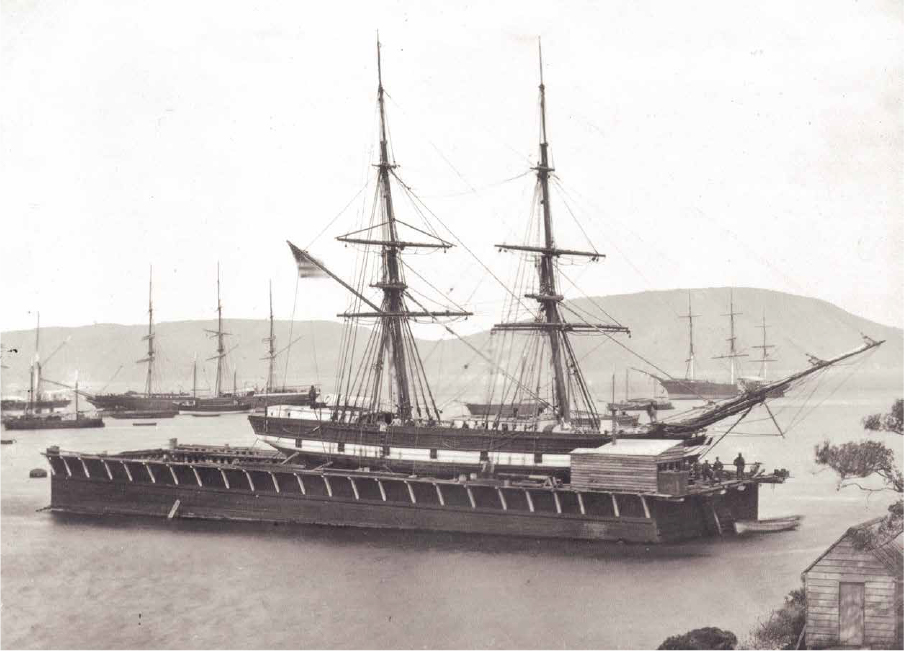
Alpha floating dock
The 500-tonnes floating dock was the first of its kind in New Zealand and could accommodate seagoing ships with draughts of up to 3.9m. At 52m long,13m wide and 5m feet deep, the Alpha Dock was the largest marine structure in Australasia at the time and could be pumped dry in four hours. Alpha was launched on 3 August 1868 and used for the first time 26 days later by Eleanor. Pictured is the American brig Emma.
Today

Always open port
Today, Port Otago is the lower South Island's main port for exports. It benefits from a deep natural harbour, a strategic location for vessel rotation to and from deep-sea destinations and a large primary export cargo region. The port leverages existing infrastructure to be always open, by using in-house dredging capability and renewable harbour defences. The team adapts quickly to provide space to customers and their changing needs. Opened in October 2024, the public viewing gallery allows our community and visitors to view the port’s operations up close.
2000s

Multipurpose Wharf extension
In 2018, extension of the Multipurpose Wharf commenced. An additional 135 metres increased the combined container wharf length to 731 metres, allowing the port to cater for log, container and cruise ships across three berths. The $23m extension was constructed using 138 32-metre-long reinforced concrete piles, each requiring 30 cubic metres of concrete in order to support the concrete wharf deck. More than 5,000 cubic metres of concrete across 11 pours was used during construction. Totalling in excess of 75,000 man hours, the project was completed five weeks ahead of schedule and opened in 2019.
1970s

Containerisation
In the 1970s containerisation changed the very look of New Zealand ports. Port Chalmers along with Auckland, Wellington, and Lyttelton reclaimed large areas of land, filled in old wharves and dry docks, demolished wharf sheds and installed massive ship-to-shore gantry cranes. In Port Chalmers, the railway piers were mostly removed to create the Container Terminal Wharf which, along with the Beach Street Wharf, allowed for two large ships to be serviced concurrently.
1960s

Beach Street Wharf
In the late 1960s rock was removed from the east side of the Port Chalmers basin to provide a trench bed for the caissons for Beach Street Wharf and to deepen part of what was to become the berths at Beach Street. A caisson is a watertight retaining structure and divers were needed during construction, often diving all day in freezing conditions with poor visibility. Rock from the caisson trench was used to backfill behind the caissons.
1930 - 1950

Goat Island channel widening
In the 1930s a rock spur which extended into the channel from Goat Island (Rakiriri) was removed by blasting. This was followed by a major project which ran from 1950 to 1955 when the channel between the islands was widened by 100 feet by cutting a bench on the Goat Island side to a depth of 30 feet at low tide. The blasting, completed in 1954, was reported to be responsible for damage to windows, chimneys and drains in the Port Chalmers area.
1900 - 1930

Otago Dock
Due to ever-increasing ship size, the construction of the Otago Dock graving dock commenced in 1905 with a timber coffer dam built by three shifts of men working around the clock under electric lighting. The dam was drained, and mud and silt excavated to make way for the foundations and stonework of the dock. Otago Dock was officially opened on 30 June 1909. Pictured is the ferry Rangatira in Otago Dock, 1930s.
1874 - 1900

Victoria Channel
The first major project undertaken by the Otago Harbour Board after its
establishment in June 1874 was the controversial dredging of the Victoria Channel from Port Chalmers to Dunedin, allowing ocean-going vessels to reach the city’s wharves. Dredge 222 lifted more than 9,000 cubic metres from Victoria Channel, from the islands to steamer basin, and from the Victoria Wharf berths in Dunedin. The channel opened in 1881 and remains key to the operation of the port today.
1873

Railway piers
In January 1873 the railway connecting Port Chalmers and Dunedin was opened for traffic by the Governor, Sir George Bowen. That same day, Lady Bowen christened the recently-built Bowen Pier, one of three railway piers, which along with the Export Pier and George Street Pier, provided deep-water berths for vessels. The Union Steam Ship Company purchased the hulk of the barque Don Juan in 1878 and moored it between the Bowen and George Street Piers for use as a carpenters workshop and sailmakers loft.
1868

Port Chalmers Dock
On 16 July 1868 Superintendent of Otago, James Macandrew wheeled the first barrow-load of rubble to start construction of the Port Chalmers graving dock, a dry dock suitable for larger vessels. The build took four years, a tremendous undertaking considering that the 1,400 tonnes of Portland cement was mixed by hand. The floor and walls were lined with 90,000 cubic feet of local Port Chalmers breccia. The first vessel to enter the gate was SS Phoebe on 12 May 1871 and the dock was commissioned in March 1872. Pictured is the HMS Dido, the first warship to use the dock in December 1872
1860s

Alpha floating dock
The 500-tonnes floating dock was the first of its kind in New Zealand and could accommodate seagoing ships with draughts of up to 3.9m. At 52m long,13m wide and 5m feet deep, the Alpha Dock was the largest marine structure in Australasia at the time and could be pumped dry in four hours. Alpha was launched on 3 August 1868 and used for the first time 26 days later by Eleanor. Pictured is the American brig Emma.
Ship Timeline
2017
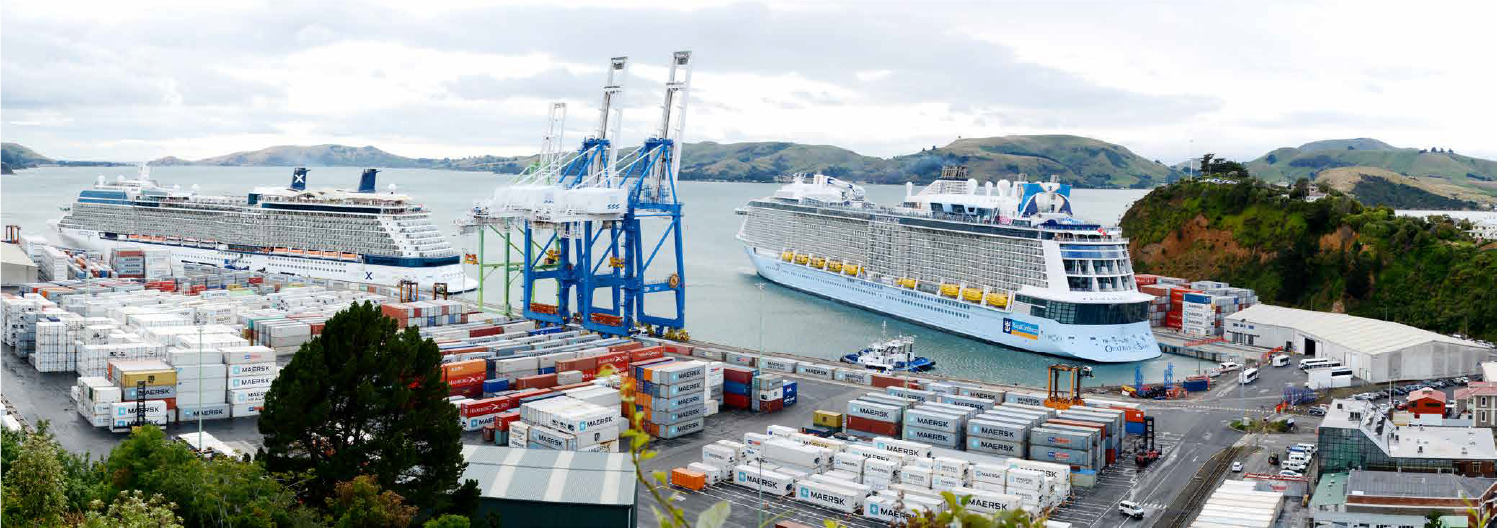
2017 Ovation of the Seas
Largest cruise ship to berth at Port Otago, her maiden New Zealand voyage included Milford Sound, but bad weather prevented a visit to Port Chalmers. She successfully berthed in January 2017 and was celebrated with a plaque exchange.
- Length 348m
- Beam 48.9m
- Draft 8.822m
- Tonnage 168,666
- Passengers 14,905 and 1,500 crew
2009
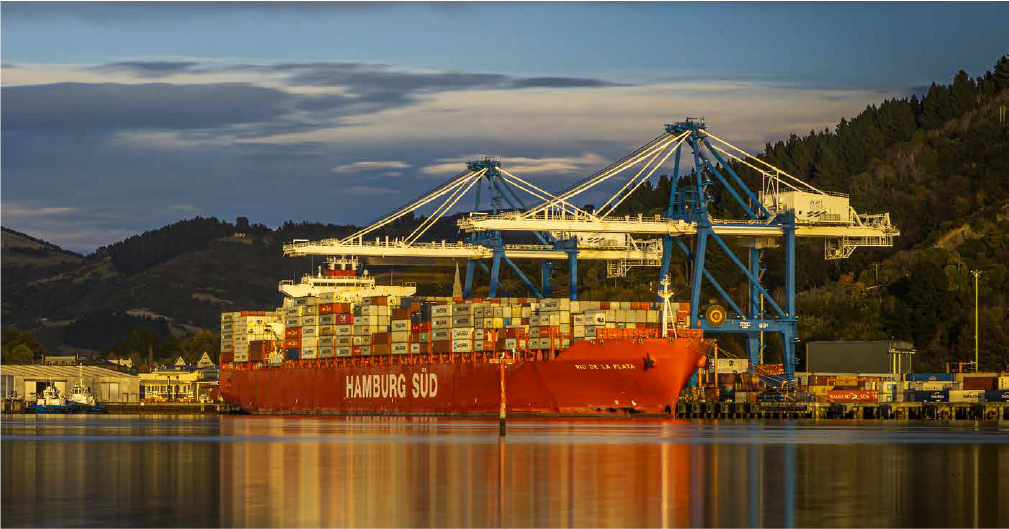
2009 Rio class container ships
First cargo ships to exceed 5000 TEU. The Rio de Janeiro is one of seven Rio-class ships to call at Port Chalmers. Port Otago worked with Maersk to retrofit silencers on the Rio-class ships to reduce the noise of the generators required to keep the refrigerated containers running while berthed, minimising noise pollution for the harbourside community.
- Length 286.5m
- Beam 40.1m
- Draft 13.500m
- Tonnage 73,899
- TEU 5,905
1971
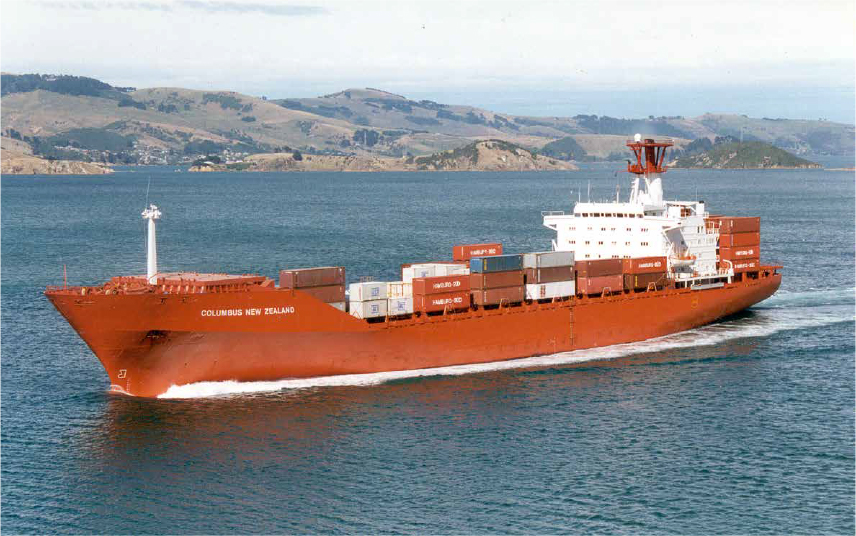
1971 Columbus New Zealand
First container ship to visit Port Chalmers, having visited Wellington and Auckland on her maiden New Zealand voyage. This red-hulled container ship, alongside sister ships Columbus Australia and Columbus America, introduced a new dimension of cargo-handling to the port.
- Length 193.99m
- Beam 29.37m
- Draft 10.850m
- Tonnage 19,169
- TEU 1187
1961
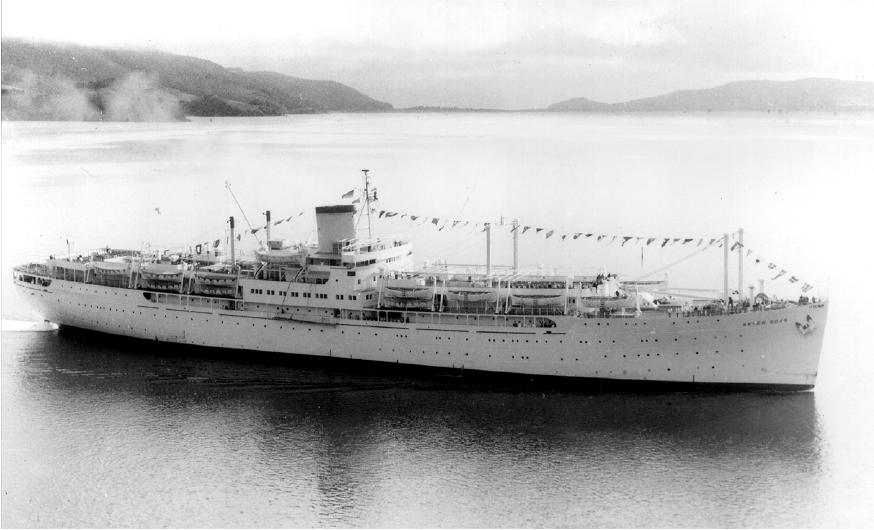
1961 Seven Seas
First modern cruise ship to visit Dunedin, built in 1940, originally a standard C3-class cargo ship that, due to WWII, was transformed into an auxiliary aircraft carrier with capacity for 16 to 21 aircraft. Postwar she was converted by Caribbean Land & Shipping Co into basic immigrant ship MS Nelly and in 1953 comprehensively rebuilt and upgraded into a two-class ocean liner.
- Length to 149.96m
- Beam to 21.08
- Draft 6.782m
- Tonnage 12,575
1926
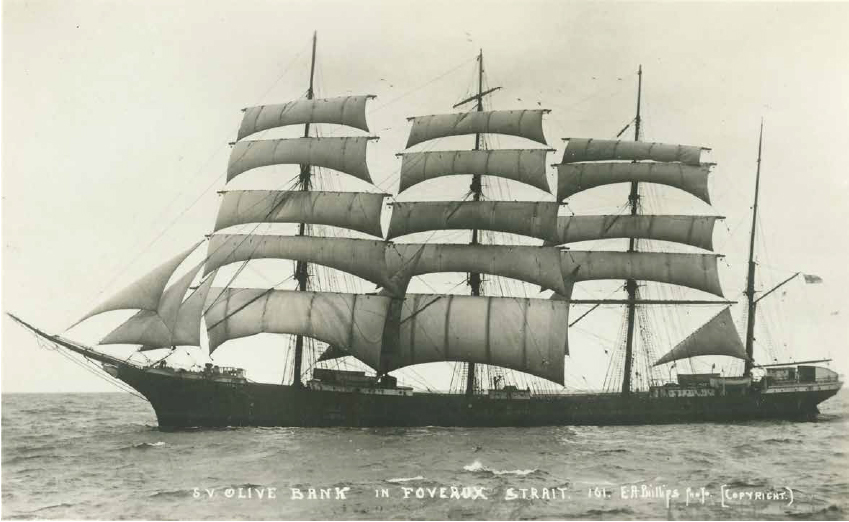
1926 Olivebank
Possibly one of the last and the largest sailing ships to work cargo on Otago Harbour, a four-masted barque built in 1892, by Mackie and Thomson, Govan, Glasgow, she was designed to provide full cargo capacity while maintaining efficient sailing qualities. She sailed from Mahe, India in August 1926 arriving in Otago in November 1926.
1905
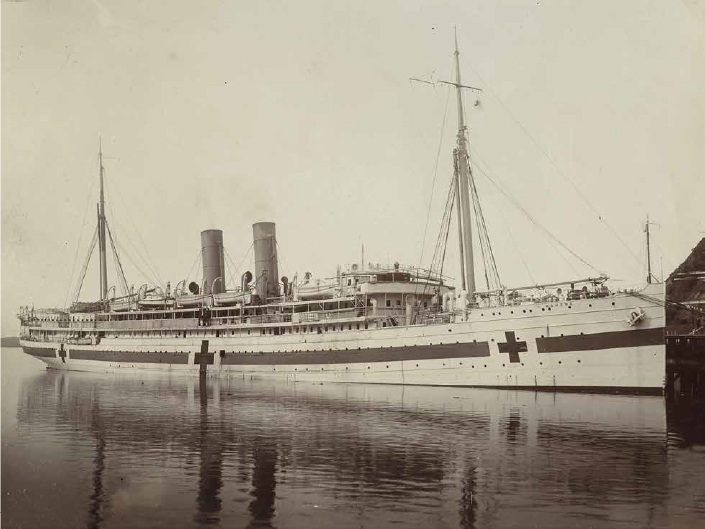
1905 S.S. Maheno
USSCo steel-hulled ocean liner that crossed between Australia and New Zealand, carrying up to 420 passengers, later converted and used as a hospital ship during WW1. While under tow to breakers she was washed ashore on Fraser Island during a cyclone in 1935.
- Length 122m
- Beam 15.3
- Depth 9.4m
- Tonnage 5,282
1882
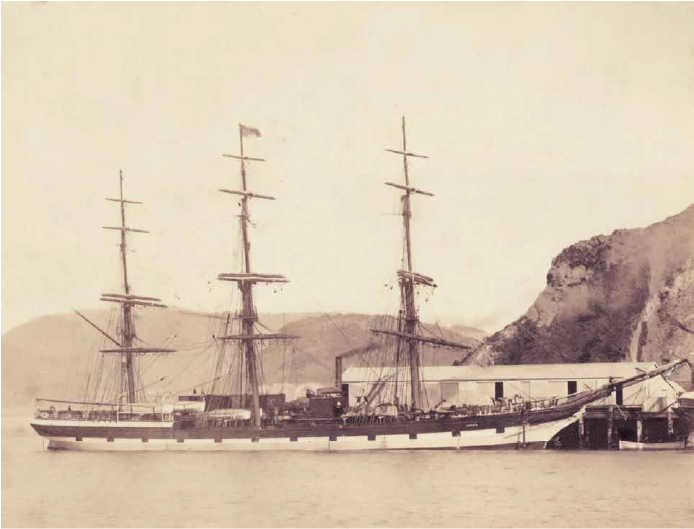
1882 Dunedin
Originally an immigrant vessel capable of carrying 400 passengers, The Dunedin was refitted with a Bell Coleman refrigeration machine that cooled the entire hold, and in 1882 left Port Chalmers for London with the first shipment of frozen meat, arriving in London 98 days later.
- Length 73.47m
- Beam 11m
- Depth 6.4m
- Tonnage 1,320
1875
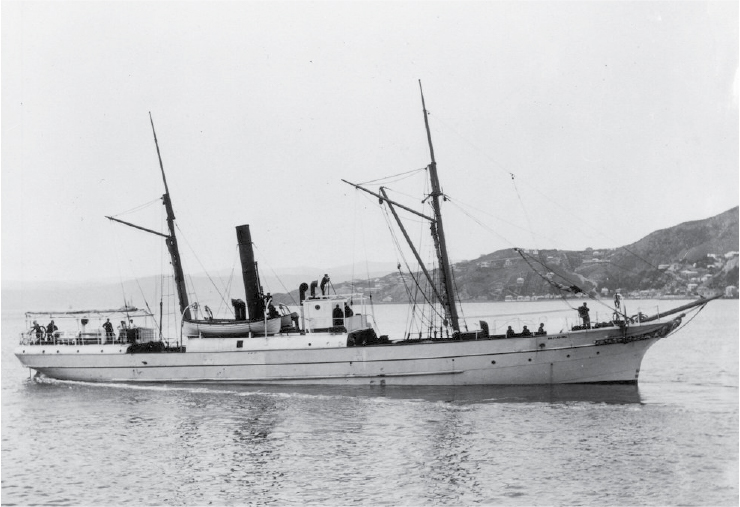
1875 S.S. Maori
Built in 1867 S.S.Maori was one of the first steamers. in 1875, to join the Union Steam Ship Company (USSCo). Powered by a compound steam reciprocating inverted direct acting engine, she also had two masts, and was schooner-rigged so could sail under canvas. Her accommodation allowed for 20 passengers.
- Length 43.9
- Depth 6.9m
- Tonnage 174
1866

1866 William Davie
One of several hundred sailing ships that brought tens of thousands of immigrants from Europe to New Zealand Vessels ranging from schooners to fully rigged barques brought supplies, before trade developed sufficiently for export vessels to become dominant. William Davie made 13 visits to Otago between 1866 and 1881.
- Length 57.0m
- Beam 9.63m
- Tonnage 841
1830s
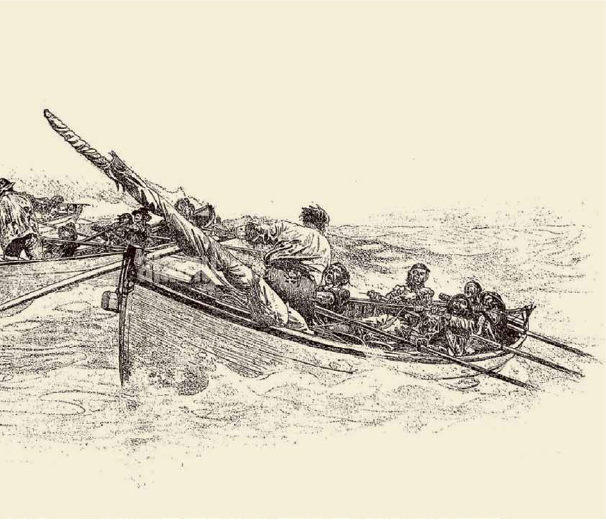
1830s Early Whalers
European sealers visited on occasion and whaling stations were established. Wellers Rock, Ōtākou, was one of the largest whaling stations in New Zealand, with local Māori joining European whaler vessels as skillful boatmen and harpooners.
- Length 8-9m
- Beam 1.6-1.8m
Pre 1800
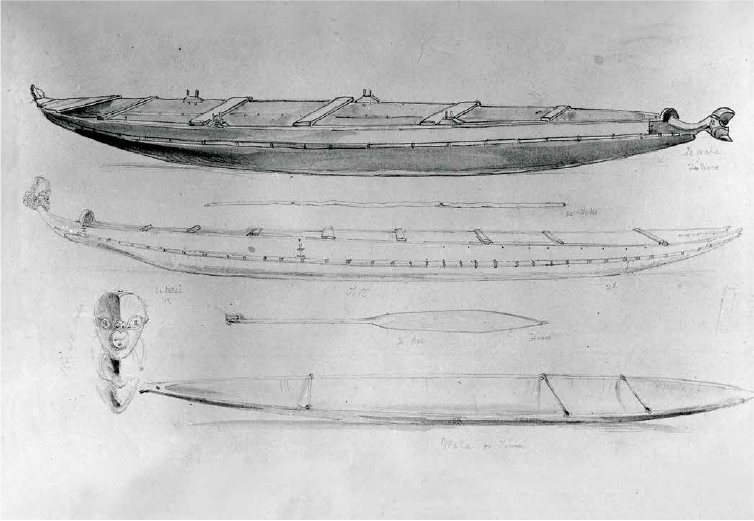
Pre 1800 Waka tētē
Local Māori used waka tētē for transport and food gathering (mahika kai) in the coastal and inland waters of Otago.
2017

2017 Ovation of the Seas
Largest cruise ship to berth at Port Otago, her maiden New Zealand voyage included Milford Sound, but bad weather prevented a visit to Port Chalmers. She successfully berthed in January 2017 and was celebrated with a plaque exchange.
- Length 348m
- Beam 48.9m
- Draft 8.822m
- Tonnage 168,666
- Passengers 14,905 and 1,500 crew
2009

2009 Rio class container ships
First cargo ships to exceed 5000 TEU. The Rio de Janeiro is one of seven Rio-class ships to call at Port Chalmers. Port Otago worked with Maersk to retrofit silencers on the Rio-class ships to reduce the noise of the generators required to keep the refrigerated containers running while berthed, minimising noise pollution for the harbourside community.
- Length 286.5m
- Beam 40.1m
- Draft 13.500m
- Tonnage 73,899
- TEU 5,905
1971

1971 Columbus New Zealand
First container ship to visit Port Chalmers, having visited Wellington and Auckland on her maiden New Zealand voyage. This red-hulled container ship, alongside sister ships Columbus Australia and Columbus America, introduced a new dimension of cargo-handling to the port.
- Length 193.99m
- Beam 29.37m
- Draft 10.850m
- Tonnage 19,169
- TEU 1187
1961

1961 Seven Seas
First modern cruise ship to visit Dunedin, built in 1940, originally a standard C3-class cargo ship that, due to WWII, was transformed into an auxiliary aircraft carrier with capacity for 16 to 21 aircraft. Postwar she was converted by Caribbean Land & Shipping Co into basic immigrant ship MS Nelly and in 1953 comprehensively rebuilt and upgraded into a two-class ocean liner.
- Length to 149.96m
- Beam to 21.08
- Draft 6.782m
- Tonnage 12,575
1926

1926 Olivebank
Possibly one of the last and the largest sailing ships to work cargo on Otago Harbour, a four-masted barque built in 1892, by Mackie and Thomson, Govan, Glasgow, she was designed to provide full cargo capacity while maintaining efficient sailing qualities. She sailed from Mahe, India in August 1926 arriving in Otago in November 1926.
1905

1905 S.S. Maheno
USSCo steel-hulled ocean liner that crossed between Australia and New Zealand, carrying up to 420 passengers, later converted and used as a hospital ship during WW1. While under tow to breakers she was washed ashore on Fraser Island during a cyclone in 1935.
- Length 122m
- Beam 15.3
- Depth 9.4m
- Tonnage 5,282
1882

1882 Dunedin
Originally an immigrant vessel capable of carrying 400 passengers, The Dunedin was refitted with a Bell Coleman refrigeration machine that cooled the entire hold, and in 1882 left Port Chalmers for London with the first shipment of frozen meat, arriving in London 98 days later.
- Length 73.47m
- Beam 11m
- Depth 6.4m
- Tonnage 1,320
1875

1875 S.S. Maori
Built in 1867 S.S.Maori was one of the first steamers. in 1875, to join the Union Steam Ship Company (USSCo). Powered by a compound steam reciprocating inverted direct acting engine, she also had two masts, and was schooner-rigged so could sail under canvas. Her accommodation allowed for 20 passengers.
- Length 43.9
- Depth 6.9m
- Tonnage 174
1866

1866 William Davie
One of several hundred sailing ships that brought tens of thousands of immigrants from Europe to New Zealand Vessels ranging from schooners to fully rigged barques brought supplies, before trade developed sufficiently for export vessels to become dominant. William Davie made 13 visits to Otago between 1866 and 1881.
- Length 57.0m
- Beam 9.63m
- Tonnage 841
1830s

1830s Early Whalers
European sealers visited on occasion and whaling stations were established. Wellers Rock, Ōtākou, was one of the largest whaling stations in New Zealand, with local Māori joining European whaler vessels as skillful boatmen and harpooners.
- Length 8-9m
- Beam 1.6-1.8m
Pre 1800

Pre 1800 Waka tētē
Local Māori used waka tētē for transport and food gathering (mahika kai) in the coastal and inland waters of Otago.